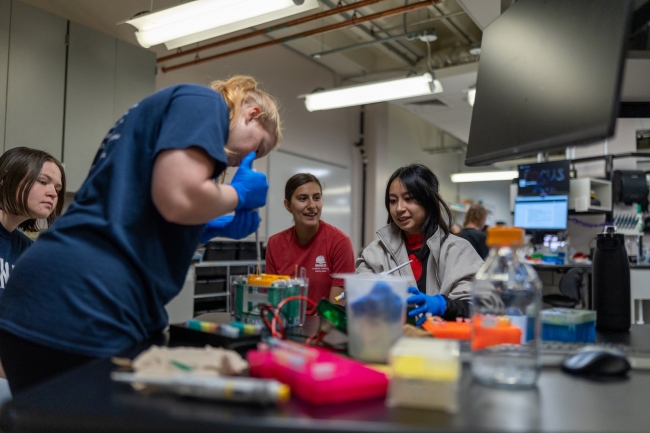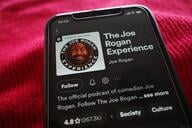You have /5 articles left.
Sign up for a free account or log in.

Students from Colorado School of Mines on a three-week field research session.
Colorado School of Mines
For several years, industry and educational institutions have been discussing the mismatch between the skills that employers demand in STEM fields and those that the available workforce possesses. Yet if we stand a chance of catching up to the rapid advancement of technology, it’s time to speed up the skills development of today’s students.
This summer, we at the Colorado School of Mines offered a field session for juniors and seniors as part of a new quantitative biosciences and engineering major. For three weeks, 42 students worked 40-plus hours a week pitching research design plans, reviewing and presenting scientific literature, writing field reports, studying manuscripts, and developing summaries of their work.
While we did not invent course-based undergraduate research experiences, or CUREs, which insert the elements of doing authentic research into a class-based environment, we have yet to encounter another example of a group of students that large doing real-world research full-time in a compressed, three-week format. Such experiences typically happen in the context of a semester-based course in which students might only be able to work on their research project a couple of hours a week during the prescribed class time. Meanwhile, they are also navigating myriad other courses, extracurriculars and responsibilities that students generally face during the academic year. In contrast, our course exposes students at scale to authentic research in a focused manner, allowing more of them to go through a true experiential learning process—while advancing research in the process.
Our inaugural course featured two concurrent projects, both designed to take on the global problem of plastic waste and recycling using biological approaches. First, students ventured to the Edgar Mine in Idaho Springs, Colo., to collect subsurface water and soil samples to try to identify microbes that may possess unique plastic-degrading genes. Then they used genetic engineering, molecular biology and biochemistry skills to design, produce and assess mutant enzymes with the goal of degrading plastics at higher rates. This second project was done in collaboration with the National Renewable Energy Lab in Golden, Colo.
Over the course of the three weeks, students worked in groups of three on both projects, experiencing actual working conditions on projects they would tackle as a practicing engineer or scientist. Such experiences help students develop the laboratory, computational, data analysis, critical thinking, teamwork and time-management skills necessary to avoid the skills gap between college training and an employer’s needs.
Students completed surveys on the first and last day of the field session and self-reported strong gains in self-efficacy for designing research projects, using laboratory and computational methods, and evaluating, analyzing and communicating data and results. Moreover, they reported gains in their feelings of belonging to the scientific community and in their feelings of scientific identity. Those results are even more important as 74 percent of the students enrolled were women, compared to the overall university enrollment of 31 percent women. That large flip in gender enrollment, coupled with the gains in self-efficacy, belonging and identity, will not only address the skills gap but also promote a more diverse workforce in the biosciences moving forward.
We were incredibly impressed with our students’ motivation, dedication, curiosity and resiliency during our intensive three-week course. Our students asked smart and relevant questions, worked together extremely well, and persevered through difficulties. For example, after doing a routine microbiology technique that nearly always works flawlessly, we were expecting to see positive results the next morning. However, only a single group had positive results. Indeed, as this course involved two real-world, authentic research projects, things didn’t always work out as planned, which is exactly how real research works. (Terrible joke alert: that is why they call it REsearch, because you have to do it more than once.) At least one of us had a sleepless night pondering what to do when the aforementioned experiment failed in the lab. However, the next morning, we brainstormed with the entire class to figure out what next steps we should take to move forward. We truly worked as one large, 46-member team to accomplish our goals.
Our students were indeed successful in examining the microbial diversity of their soil and water samples and in producing mutant enzymes. But again, because this was real research, results were mixed, and many more questions have been generated than answered. We will be able to use their results in other courses and future field sessions to continue to investigate biological solutions to plastic degradation.
With this dedicated, three-week course model of experiential learning, we have been able to show that students at scale can develop scientific and technical skills, increase feelings of belonging and identity, and make progress toward addressing real-world environmental, social and ethical problems. This course model can be mimicked at other institutions so as to bring more authentic work experiences to students across the country.
An important lesson we learned through this process is how critical it is to pilot the project ahead of time. Without spending time the prior academic year in the lab trying everything out, ultimate failure would have been certain. Second, and more important, is the need to just roll with it! No matter how well laid out our plans were, things often went astray working at scale with students. Our best advice is to take a breath, think together as a group and make the most of this distinctive, enriching experience. We strongly believe that the focused, full-time and experiential nature of this course was key to our students’ success and that they are now extremely well prepared to enter the careers of their choice.




